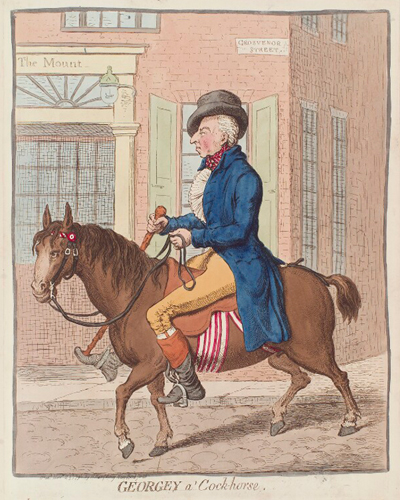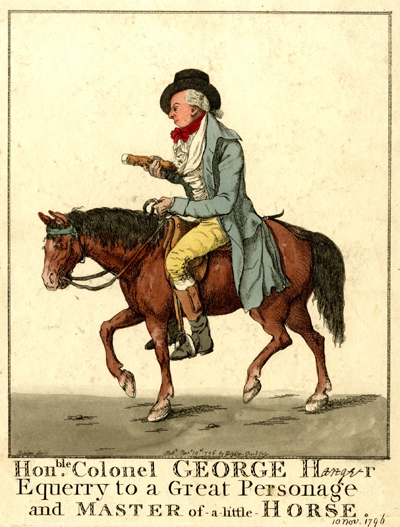Georgey a' Cock-Horse
Georgey a' Cock-Horse is a brilliant and unusual portrait caricature of Colonel George Hanger, long-time friend and carousing partner of the Prince of Wales, riding on his favorite Scotch pony. According to a poem written by the Marquis of Townshend you could tell where the bon ton could be found by looking for Hanger's well-known steed.

© National Portrait Gallery, London
With sly wit, Gillray shows the Colonel riding past an actual coffee shop called "The Mount" on Lower Grosvenor Street. The cock in the title may allude to the well known nursery rhyme and thus refer to the toy-like size of the pony. But the term can also refer to a horse who has not been castrated, and given Hanger's reputation as a womanizer, the title could be read as if it had a colon—Georgey: a Cock Horse.
As the third son of an MP who later became an Irish peer, Colonel George Hanger spent the early part of life educated in and involved with the military, serving for a time in the American war. But he seems to have been at best an indifferent soldier, and his promotions in rank were largely purchased not awarded.
What he was good at was gaming, carousing, and womanizing, and by 1785 he had struck up a friendship with the very person who could best appreciate his talents—the Prince of Wales. In Hanger's Shandean memoirs, he talks about spending the pleasantest three years of his life as a frequent visitor in Brighton with the Prince and Mrs. Fitzherbert. Perhaps not suprisingly, then, he first seen in Gillray's work as one of the imagined wedding party in Wife & No Wife, or a Trip to the Continent (1786) which supposedly portrays the secret continental wedding of the Prince. And with his trademark bludgeon under his arm, Hanger also appeared as the central figure in Rowlandson's Box Lobby Loungers (1786) talking to two prostitutes. And if Gillray's prints about the the 1788 Westminster by-election are any indication, Hanger was an active supporter of the Prince's friend and Whig candidate, Lord John Townshend. Hanger appears in at least five Gillray election prints including Mason, the Duke's Confectioner. . ., Blood & Co, Setting Fire to the Tower. . ., and The Butchers of Freedom. No doubt because of his love of horses and the turf, he became Equerry to the Prince in 1791.
But between 1788 and 1796 Hanger largely disappeared from Gillray's notice. He seems to have been brought back by Robert Dighton, a specialist in small to medium etched portraits whose November 10th print of Hanger on his pony clearly served to inspire Gillray's Georgey a' Cock-Horse two weeks later.

Hon.ble Colonel George H----r [Nov. 10, 1796]
© Trustees of the British Museum
But in my experience when Gillray find himself in the rare position of follower, not leader on a subject, he usually comes out with a print that then reasserts his dominance in the field by crushing the competition. And that, I think is what we see here in comparing the two portraits.
Robert Dighton was essentially a portraitist and engraver, creating many hundreds of print portraits before handing off the business to his son Richard to carry into the Victorian era. His portraits in the 1790s fall into the tradition of portrait caricature insofar as they are mostly full length, in profile, against a blank background. But they are scarcely caricatured and unlike the Darly prints in this case, the subject is all but explicitly named.
Gillray's image would have been more imposing, first of all, by being larger. Dighton's is roughly 8 inches by 6 inches; Gillray's is approximately 12 x 10. But even as a portrait, Gillray's print is finer. Hanger's face, his posture, his clothes, are all better delineated and more convincing. Gillray's Hanger knows how to ride. Even his horse seems to have more life in him. And finally, the beautifully depicted background besides supplying satiric commentary, provides an extra sense of depth and fullness to horse and rider, setting a new standard in the finish and fidelity of Gillray's portrait caricatures.
Sources and Reading
- Commentary from the British Museum on Georgey a' Cock-Horse
- "George Hanger, 4th Baron Coleraine," Wikipedia
- The life, adventures, and opinions of Col. George Hanger
- Thomas Wright and R.H. Evans, Historical and Descriptive Account of the Caricatures of James Gillray #426.
Comments & Corrections
NOTE: Comments and/or corrections are always appreciated. To make that easier, I have included a form below that you can use. I promise never to share any of the info provided without your express permission.